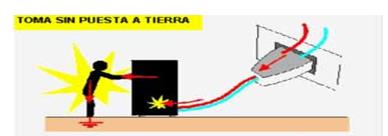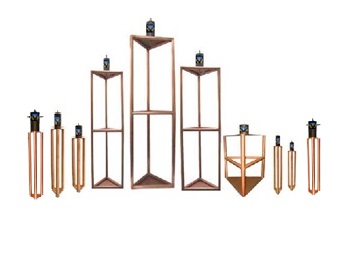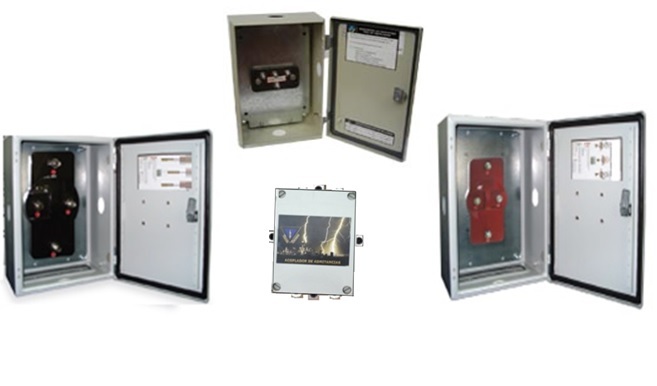What is a grounding system?
A grounding system is a set of electrical conductors (cables and electrodes) directly buried in the ground and distributed through an installation expressly designed to withstand exceptional currents in the event of a short circuit or atmospheric discharge, among other eventualities The current goes to the point of least resistance.
What is the importance of having an efficient grounding system?
If there is no grounding system or if there is an inefficient grounding system, in the event of a fault current, the current is directed to the path that offers least resistance, causing an electrical accident when passing through the body of the person to reach land.

The grounding system offers security against an electrical accident or static electricity discharges, by offering a path of least resistance where the current is directed without affecting personnel.

TERRAGAUSS ELECTROMAGNETIC GROUNDING SYSTEM
The Terragauss grounding system is the latest generation of Physical Grounds, designed to provide absolute security for the physical integrity of people, protection of electrical and electronic equipment, as well as savings in energy consumption. It is a multi-grounded system that drains faults through different points and returns any type of induction to ground.
The Terragauss grounding system is patented before the IMPI (Mexican Institute of Industrial Property).
It is constituted by:
Electromagnetic electrode and LCR device.

Hygroscopic electroconditioning compound for floors

Mass and impedance coupler.

Features of the Terragauss electromagnetic grounding system
1. Allows to reach a resistance permanently minor to 2 ohms.
2. Returns to ground any induced current such as lightning, parasitic currents, electromagnetic and radio frequency interference, circulating in the subsoil, etc., preventing voice, data, card, UPS, etc. equipment from being damaged.
3. A voltage difference between neutral and ground significantly less than 0.5 V, achieving reference "logical zero" by avoiding potential gradients between neutral and ground allowing proper operation of the equipment.
4. Provides equipotentiality (continuity) between the Terragauss electromagnetic grounding system and the landed structures in a 160m diameter, avoiding time and cost of civil works (connectors, conductors, pipes, conduits, etc.) by not requiring interconnection with other ground systems to achieve equipotentiality.
5. Minimizes noise and radio frequency interference and electromagnetic interference.
6. Reduce vandalism with less cables and keeps working even with partialy vandalized places.
7. Doesn't requires any kind of maintenance.
8. 10 years performance .
Terragauss Grounding Systems comply with national and international standards for the ohmic resistance value, measured with the Fall of Potential Method or 62%.
| NORM | APPLICATION | RESISTANCE VALUES IN OHMS |
| NOM-022-STPS-2015. STATIC ELECTRICITY IN WORK CENTERS - SAFETY CONDITIONS. SECTION 9.2 F | LIGHTNING ROD
GROUNDING | < 10
<25 |
| NMX-J-549-ANCE2005. PROTECTION SYSTEM AGAINST ELECTRIC STORMS. ITEM 4.3.4 | LIGHTNING ROD | <10 |
| NOM-001-SEDE-2012. ELECTRICAL INSTALLATIONS. SECTIONS 250-50, 250-53; 921-25, 921-18 | HOUSES, SHOPS, LOCAL OFFICES CONSIDERED AS PUBLIC CONCENTRATION
HIGH RESISTIVITY GROUNDING
SINGLE ELECTRODE SYSTEMS
UNDERGROUND
TRANSFORMERS GREATER THAN 250 KVA, MAXIMUM VOLTAGE GREATER THAN 35 KV
TRANSFORMERS OVER 250 KVA, MAXIMUM VOLTAGE OF 35 KV
250 KVA TRANSFORMERS, 35 KV MAXIMUM VOLTAGE | <25
25
25
5
5
10
25 |
| NOM-151-SCT1-1999. INTERFACE TO PUBLIC NETWORKS FOR TERMINAL EQUIPMENT. SW TELECOMMUNICATIONS FEDERAL COMMISSION. ITEM 5.1.11 | SENSITIVE EQUIPMENT
SINGLE ELECTRODES | <5
<25 |
| NEC 250.56, 250-84 (2017) NATIONAL ELECTRICAL CODE | SENSITIVE EQUIPMENT
SINGLE ELECTRODES | <5
<25 |
| NFPA-780 (2018).ESTÁNDAR PARA LA INSTALACIÓN DE SISTEMAS DE PROTECCIÓN CONTRA RAYOS | LIGHTNING ROD | <10 |
| IEEE STD 142-2007 .RECOMMENDED PRACTICES FOR GROUNDING OF INDUSTRIAL AND COMMERCIAL ELECTRICAL SYSTEMS. SECTION 4.1.2 RECOMMENDED ACCEPTABLE VALUES | LARGE COMMERCIAL AND INDUSTRIAL SYSTEMS AND INDUSTRIAL PLANTS SUBSTATIONS
HIGH AND EXTRA HIGH VOLTAGE TRANSMISSION LINES OR GENERATOR SUBSTATIONS | BETWEEN 1-5
<1 |
| IEC 60364-4-442 (2007), ANSI/IEEE 80, NTC 2050 and 4552, International Electrotechnical Commission) (International) Electrical installations. Protection to guarantee the security. Protection against electric shock. | TRANSMISSION LINE STRUCTURES
MEDIUM VOLTAGE SUBSTATIONS
LIGHTNING PROTECTION
LOW VOLTAGE SUPPLY NEUTRAL
TELECOMMUNICATIONS SYSTEMS | 20
10
10
25
5 |
| NRF-011-CFE-2004 | HIGH VOLTAGE POWER SUBSTATIONS.
MEDIA DISTRIBUTION SUBSTATIONS
MEDIUM VOLTAGE SUBSTATIONS | ≤1
5
1-4 |
Advantages over traditional systems: rods, pinwheels, chemical electrodes
PowerPoint Presentation
| FEATURES | CONVENTIONAL | TERRAGAUSS |
| Guarantees permanent resistance of less than 2 Ohms regardless of humidity, temperature, chemistry or soil hardness. | Doesn't, because the soils corrode due to the salts in the soil and the chemicals used, which reduces the amount of copper in the rods and consequently increases the ohmic resistance. | Yes, because when coupling the metal structures, a resistance of less than 2 Ohms is guaranteed and it is permanent because the negative electric field generated considerably retards the effect of the galvanic couple and therefore corrosion. |
| Returns to earth any current induction such as: lightning, parasitic currents, IRF, IEM, etc., coming from the subsoil. | Doesn't, are designed for this application. | Yes, due to the combined effect of the mass and impedance coupler and the LCR device, which return the induction to ground, preventing it from reaching the equipment and damaging it. |
| Equipotential areas. | SHORT TIME due to the rapid deterioration of the rods due to the effect of soil corrosion and the chemicals used to lower the ohmic resistance. | PERMANENT, since the electrode is 100% copper and by generating a predominantly negative electric field, the cathodic effect is created that substantially retards corrosion. |
| Provides a logical "0" for computer and telecommunications equipment. | Doesn't provides it permanently. | Yes, since the values of voltage difference between neutral and earth are of the order of 0.07 Volts in all contacts. |
| It requires interconnection of the entire physical earth network to achieve equipotentiality. | Yes, to achieve equipotentiality. | Doesn't, because the system generates a negative electric field that operates as a virtual copper field, achieving equipotentiality in an area of 160 m in diameter, which is verified by measuring continuity. |
| Operation in partially vandalized sites. | Doesn't, because it requires interconnection with the land network. | Yes, because it does not require interconnection with the earth network, since it is magnetically connected, so it continues to work if the cables are stolen, in the case of the electrode being stolen, the mass coupler can drain the fault currents, until the site is replacement. |
| Requires soil resistivity studies. | Yes, to determine the maximum resistivity of the soil that varies according to the seasons and from one year to the next, to later calculate the number of rods necessary to give the desired resistance. | Doesn't, because the system does not depend on the resistivity of the, since regardless of these factors the system offers a resistance of less than 2 Ohms. |
| Installation times. | Older than 1 week, this depends on the type of soil and the number of electrodes to be installed | Between 1 and 1/2 días. |
| Installation costs. | Higher costs per site, because they require considerable more electrodes or rods, cables, installation materials, welds, pits, pipes and labor. | Lower costs per site are required less electrodes, cables, installation materials, welds, pits, pipes and labor. |
| It prevents the equipment from being damaged by current inductions coming from the subsoil. | Doesn'ton the contrary, they can induce parasitic currents coming from the subsoil, water pipes and metallic structures towards the equipment. | Yes, the mass and impedance coupler, together with the LCR coil avoid any kind of current induction reaches the equipment, returning it to ground. |
| Reduce vandalism. | Doesn't, it reduces it. | Yes, because uses less cables and electrodes, it also offers a multi-landed system that can keep running even with the vandalized site. It has as a solution the usage of cables and steel galvanized rings, to discourage and reduce vandalism. |
| Maintenance required. | Yes, because they degrade by oxidation, and require chemicals to be added to lower the resistance, but the chemicals corrode the rods that are made of steel with a hundredth of an inch of copper, requiring a constant change of rods and chemicals. | Doesn't, because they are made of copper and the system, by generating a permanent cathode field, slows down the effect of corrosion on the electrode. In addition, the compound absorbs water and retains it. |
| Guarantee | Doesn't, no conventional ground system offers guarantees. | Yes, offers a written guarantee of operation of 10 years. |
For more information:
International Trading
Tel.:53792800/01
www.internationaltrading.com.mx